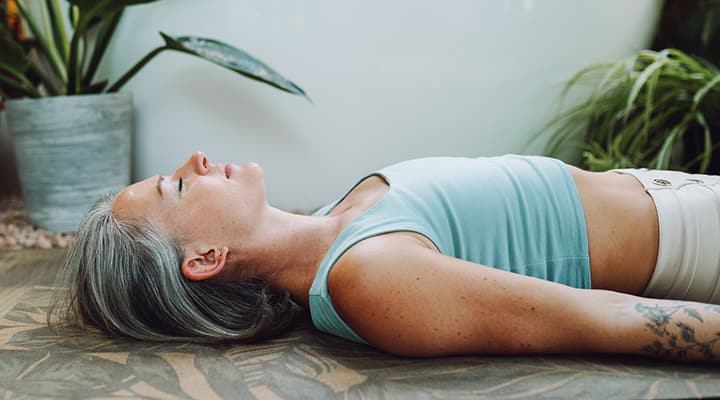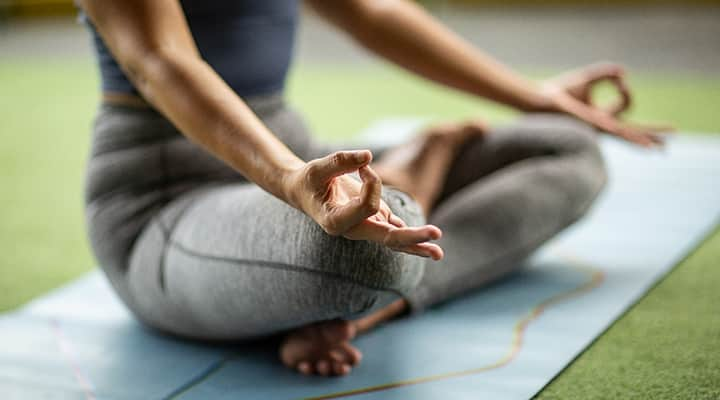
Yoga Nidra: Explore Your Inner World Through Meditation
Published: August 2024
I enjoy using a variety of styles from my yoga toolbox, such as new challenging poses and pranayama (breath work). But it is important to honor the body that needs a slow yin stretch or gentle restorative style.
Then there is a yoga practice that's even less physical: yoga nidra.
Guided yoga nidra has become one of my favorite relaxation techniques because it allows the body to reap the calming benefits of a full-blown yoga flow with very little effort. This powerful meditative practice is an important tool in healthy stress management and healthy sleep support.
What happens in yoga nidra?
Yoga nidra, or yogic sleep, is a form of guided meditation that leads to deep rest. A 20-minute yoga nidra session can be as restorative as hours of sleep, even if you don't actually sleep during the class.
Guided yoga nidra looks like an entire yoga session in the final pose of a yoga flow, savasana, where a yogi rests on a mat comfortably in stillness. During this guided meditation, the yoga nidra teacher leads yogis through an inner journey, systematically focusing on relaxing each body part in detail, one after another.
Then yogis are gently guided to bring their awareness back into an alert state in the present moment. The practice of yoga nidra can help rejuvenate the mind and body, which makes it a great complement to any workout. It can help you feel focused and energized and can help provide relief from day-to-day stress.
How to perform yoga nidra
Guided yoga nidra can be led by a yoga nidra teacher or a recording.
- Settle into corpse pose, savasana, with legs straight and palms facing up, or choose another comfortable position laying down. If you are not comfortable or worry about falling asleep, this practice can be done seated as well.
- Once situated, close your eyes and set a personal resolve or resolution, known as a sankalpa. This can be a positive thought, affirmation, or intention, like "Let go of any tension held in my physical body and release with it mental clutter so I live in full potential and harmony."
- Focus on your breathing. Concentrate on the breath, the slowness and pauses in between the inhales and exhales, how the air sounds and feels as it enters through the nose. Follow your breath as it enters the body through the chest into the belly and notice the relaxation of the body during the exhales.
- Begin a body scan, focusing on a singular part of the body, then another. (For example, relax each one of your fingers, spread into the palm, up and around the wrist, then up the arm through the elbow, allowing the release to expand into the shoulder.) Your attention will be systematically guided from fingers to toes and through the middle of your body from head to feet.
- Visualize in the mind the part of the body being called to release tension and how it loosens up at will. Hold this awareness and focus. Also pay attention to your breathing and how it helps to calm the mind and body. This is where the mind-body connection is created.
- When the body scan is done, bring awareness to the sensation of the relaxed body, and reaffirm your sankalpa. This reaffirmation can be a transformative tool for personal growth and goal setting.
- If this practice is used for guidance into sleep, then continue to fall into deep sleep.
- If this practice is a tool for personal growth, I would recommend a journaling session afterward.
Explore Our Best Stress Management Supplements
How is yoga nidra different from meditation?
Although yoga nidra is a form of meditation and they both promote mental and emotional well-being, there is a slight distinction. The practice of yoga nidra is specifically designed to bring deep relaxation and transformation through a state of conscious sleep. Traditional meditation focuses on maintaining alert awareness and mindfulness.
A sense of balance and inner peace can be achieved with both, and both encourage healthy stress management. But research has shown yoga nidra is slightly better at fighting unmanaged stress and worry. It is particularly effective to help release stress when combined with other modalities like Om chanting.
Did You Know?
A well-known yoga teacher and philosopher, Satyananda Sarawati, founded yoga nidra and the Satyananda yoga tradition. Swami Satyananda's goal with the practice of yoga nidra was complete relaxation, which makes it suitable for yogis of all skill levels.
What happens to the brain in yoga nidra?
We know healthy sleep can help refresh and reset the brain, and guided yoga nidra works much the same way. This practice uses your inner resources and awareness as a powerful relaxation technique that activates the parasympathetic nervous system, shifting the body out of fight-or-flight stress response to the rest-and-digest state.
The brain during the practice of yoga nidra is not in an unconscious deep sleep but in conscious rest. When being guided to move your focus from one part of your body to another, the heightened awareness of the body stimulates the brain.
Brain scans have shown a release of endogenous dopamine from the practice of yoga nidra. Other research has found this type of guided meditation promoted a positive mood, improved sleep quality, and increased self-esteem among participants. It has been studied to reduce levels of the stress hormone cortisol and promotes relaxation better than listening to music.
Should you do yoga nidra in bed?
It's good to do this guided meditation with a yoga mat so you associate this practice with inner focus and not with falling asleep. But if falling asleep faster is your goal, you can also do a 20-minute yoga nidra session in bed before you sleep. Either way, you may want to use a light blanket, as your body temperature tends to drop with relaxation.
This type of yoga may work more effectively as a transformative meditation on an empty stomach, so allow a few hours to digest a full meal before your yoga nidra practice. You may want to place a blanket or flat pillow under your lower back to support the savasana position.
Who is this practice for?
Yoga nidra is not just for a seasoned yogi; it is a practice accessible to everyone. Those who find meditation challenging can enjoy this meditative state of awareness, which helps regulate the nervous system and delivers so many benefits for restful sleep, healthy stress management and more. Give it a try and recommend it to someone you love. It is my hope that everyone can use a range of yoga modalities to live their best lives feeling good in their bodies.
Yoga and healthy nutrition can work hand in hand to support healthy stress management and mood. Take our health needs quiz and get a personal recommendation on the nutrients that might be right for you.
About the Author: Renee Kwok is yoga instructor who has taught various yoga styles and levels for more than 13 years. Her passion is showing others how to achieve clear mindset, vitality and wellness by connecting the mind and body. When she’s not teaching yoga, she offers Reiki energy therapy and intentional journaling, and she continues to explore healthy alternatives to nourish the body and mind as we age gracefully.
References
- Datta K, et al. "Yoga nidra practice shows improvement in sleep in patients with chronic insomnia: A randomized controlled trial." Natl Med J India. May-June 2021. https://pubmed.ncbi.nlm.nih.gov/34825538/
- Dol KS. "Effects of a yoga nidra on the life stress and self-esteem in university students." Complement Ther Clin Pract. May 2019. https://pubmed.ncbi.nlm.nih.gov/31003664/
- Ferreira-Vorkapic C, et al. "The Impact of Yoga Nidra and Seated Meditation on the Mental Health of College Professors." Int J Yoga. September-December 2018. https://www.ncbi.nlm.nih.gov/pmc/articles/PMC6134749/
- Gunjiganvi M, et al. "Efficacy of Yoga Nidra on Depression, Anxiety, and Insomnia in Frontline COVID-19 Healthcare Workers: A Pilot Randomized Controlled Trial." Int J Yoga Therap. January 2023. https://pubmed.ncbi.nlm.nih.gov/37327384/
- Kjaer TW, et al. "Increased dopamine tone during meditation-induced change of consciousness." Brain Res Cogn Brain Res. April 2002. https://pubmed.ncbi.nlm.nih.gov/11958969/
- Pandi-Perumal SR, et al. "The Origin and Clinical Relevance of Yoga Nidra." Sleep Vigil. 2022. https://pubmed.ncbi.nlm.nih.gov/35496325/
- Rajagopalan A, et al. "Effect of Om chanting and Yoga Nidra on depression anxiety stress, sleep quality and autonomic functions of hypertensive subjects - a randomized controlled trial." J Basic Clin Physiol Pharmacol. June 2022. https://pubmed.ncbi.nlm.nih.gov/35689170/
- Sharpe E, et al. "A closer look at yoga nidra- early randomized sleep lab investigations." J Psychosom Res. March 2023. https://www.ncbi.nlm.nih.gov/pmc/articles/PMC9973252/
Always be in the know!
Access the latest deals, wellness news, expert health tips & more!










